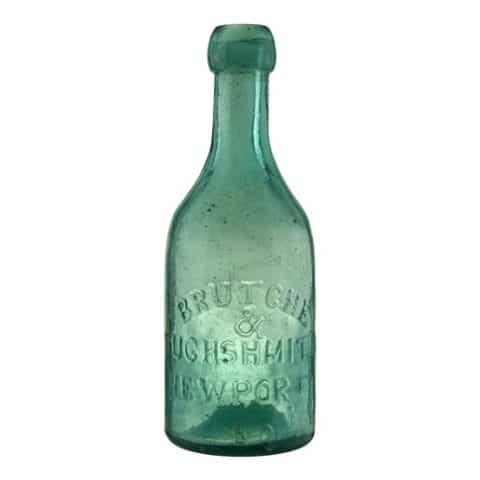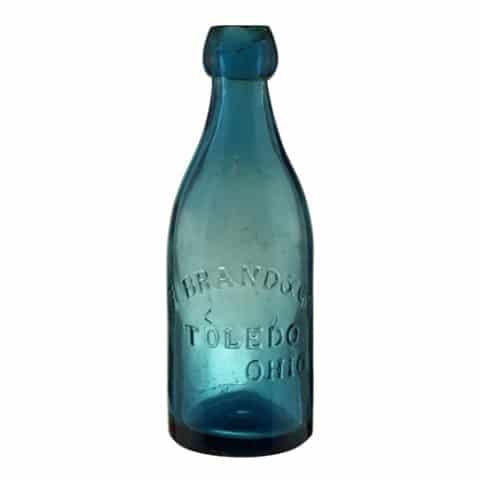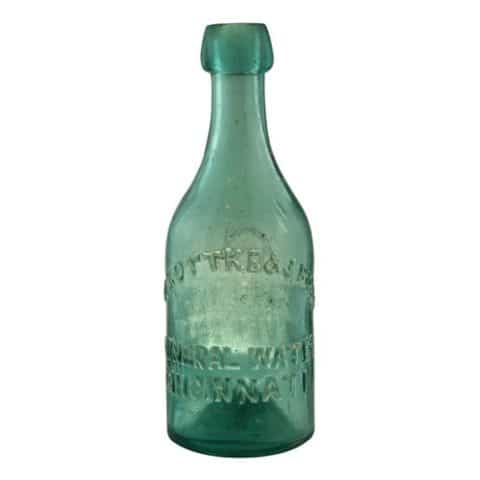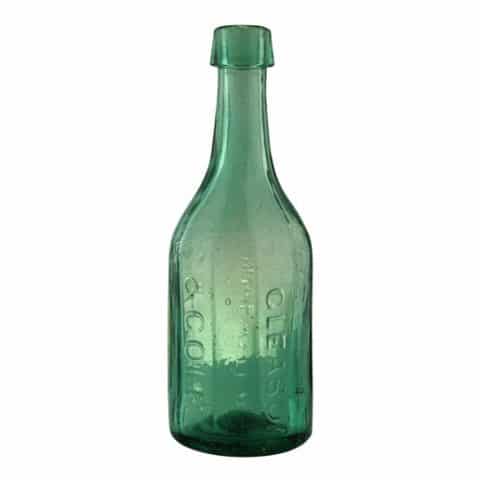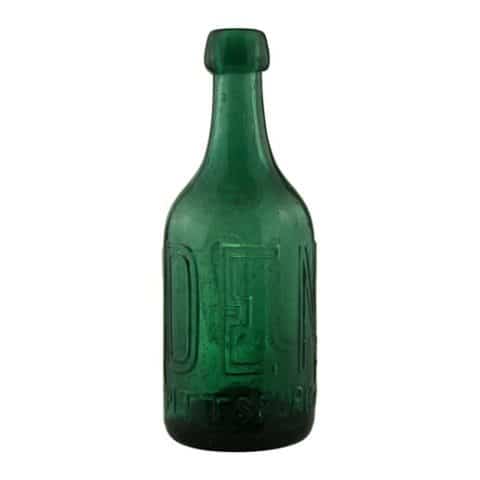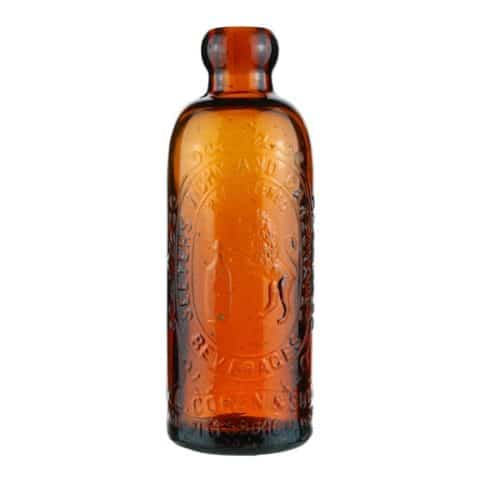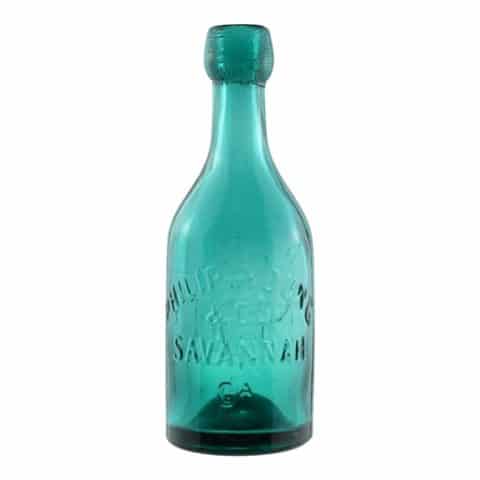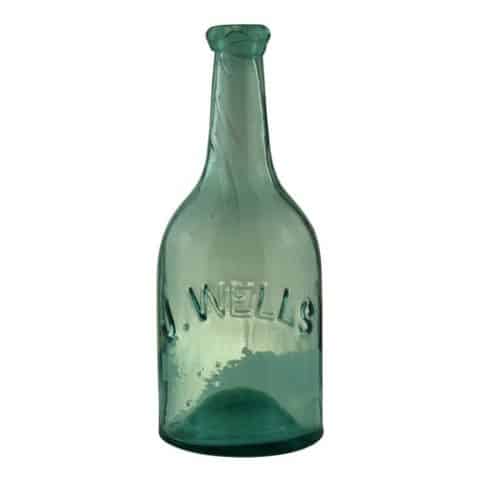Christian Schlepegrell Charleston SC
Christian Schlepegrell
Soda Water
Charleston S.C.
Return This Bottle
Christian Schlepegrell, Charleston, South Carolina
Cobalt Blue Sided Soda Water
Provenance: Mike Newman Collection

German immigrant Christian Schlepegrell was briefly a soda water manufacturer at 37 Line Street in Charleston, South Carolina, from 1850 to 1854. Little is known about his bottling business, his partner, or why the venture only lasted four years. Perhaps Schlepegrell’s partner was John L. Kornahrens, another local soda bottle manufacturer.
By 1854, Christian Schlepegrell retired from selling soda water and returned to Germany. He lived in his homeland for over a decade before returning to Charleston, where he opened a lumber business at his old address. He became a well-known and established lumber dealer and building supply merchant in Charleston for over two decades. Numerous advertisements from the 1870s through the 1880s note various items he sold. While Schlepegrell’s soda water business was short-lived, three types of rare soda bottles were embossed with his name.
Christian Julius Schlepegrell was born March 18, 1826, in Hanover, Germany, the son of Christian Julius Schlepegrell Sr. and Anna von Dohlen. According to passenger and immigration records, Christian emigrated to America in 1844 and settled in Charleston. The eighteen-year-old Christian was one of over a million Germans in this decade who came to America to escape economic hardship and for a new opportunity. These Germans also fled the political unrest caused by riots and rebellion, which eventually turned into a revolution by 1848.
Schlepegrell was among his compatriots since Charleston had a strong German ethnic community before the Civil War. In the 1840s, one could find a German grocery and other retail stores on almost every corner. There was a German newspaper (the Deutsche Zeitung), a firefighting company, and six militia companies. Charleston had also remained one of the busiest port cities in the country and, by 1849, had begun construction of the new United States Custom House.
By 1850, Schlepegrell had established a soda water manufacturing business at 37 Line Street. The following year he petitioned the city “for restitution of a tax paid on soda water, Laid on the table.” The outcome of any restitution is unknown.

Three types of soda bottles were made for Schlepegrell. The first eight-sided bottle has a graphite pontil and tapered blob top. It stands 8 ¼ inches high and 2 ½ inches in diameter at the base. It is embossed vertically on sides ‘CHRISTIAN SCHLEPEGRELL (side three), ‘SODA WATER’ (side 5), ‘RETURN THIS BOTTLE’ (side 7), and ‘CHARLESTON, S. C.” This is the feature cobalt blue bottle in the gallery.
Another bottle type is the same, except the first panel is embossed, ‘CHRISTIAN SCHLEPEGRELL & CO.’ The bottle’s embossed ‘& CO.’ indicates he had a partner who might have been John Lewis Kornahrens. In the early 1850s, Kornahrens was a grocer at 24 Line Street, just down the road from Schlepegrell. He started his soda works in the early 1850s before partnering with baker Frederick Steinke, another early soda bottler. Both bottles can be found in shades of blue and green glass. The last type is a straight-sided pony-shaped bottle in emerald green with a tapered blob top and iron pontil embossed just below the shoulder in small letters, ‘CHR SCHLEPEGRELL.’ The “R” in “CHr” is smaller and raised.
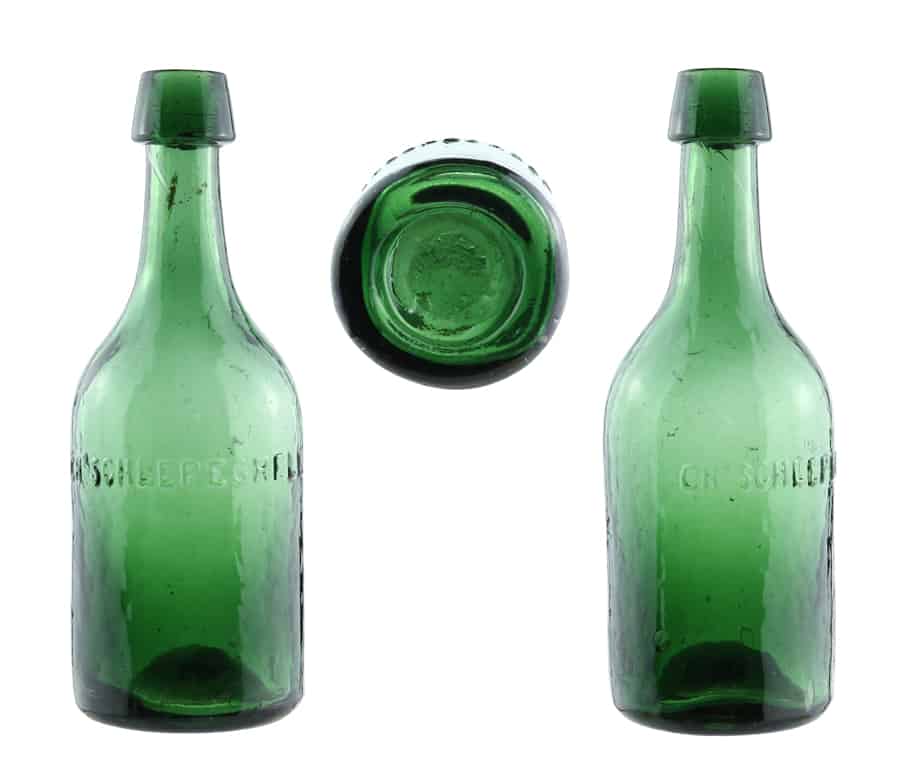
See the Museum example of the green “Chr Schlepegrell” bottle.
On October 8, 1850, Christian Schlepegrell married in Charleston to Catherine Margaret Anna Kornahrens. It’s possible that Catherine, who also went by Margaret or Margaretha, and the bottler John Lewis Kornahrens were related, but the connection is unknown. However, Christian’s career as a soda water manufacturer in Charleston ended in 1854, and he made plans to return to Germany. Perhaps there were business opportunities for him there since the revolution had made Germany “politically barren” with a stimulated economy which turned into the “great breakthrough of industrial capitalism.”
In 1854, Christian filed a U.S. passport application for returning to Hanover, Germany. On the application, he gave the following information and description: “C. J. Schlepegrell, Age 28, Height: 6 ft. 1 ½ inches, Color of hair and whiskers: light brown, Eyes: blue, Complexion: fair, Forehead: prominent, Nose: large, Mouth: large, Face: long.” Sometime after, Christian sailed back to Hanover.
While in Germany, Christian and Catherine had at least five children: Christian Julius Schlepegrell Jr. (1856-1919), George Schlepegrell (1857-1929), John August Christian Julius Schlepegrell (1859-1901), William Schlepegrell (1860-1928) and Wilhelmine Schlepegrell (1863-1928). It is not known what Christian did for a living in Germany. He lived there for over a decade before he returned to Charleston with his family.

By 1866, Christian had returned to Charleston and his old place at 37 Line Street. One has to wonder if he ever sold this property and building since he took it up so quickly on his return. An 1866 tax assessment for C. J. Schlepegrell indicates he was in business as a “retail dealer in liquor.” However, this business lasted only a short time, for in the same year, he changed it dramatically by becoming a lumber dealer.
Christian made a good choice in starting a business in lumber at this time. Most of Charleston was destroyed by the Union Army during the Civil War and needed to be rebuilt. One of Christian’s first newspaper ads was in 1866 and said, “C. J. Schlepegrell, No. 37 Line Street, between King & St, Philips, Lumber of every description and building material constantly on hand at the lowest market prices.”
In 1867, Christian placed an ad saying, “Shingles, &c – We direct the attention of builders to the advertisement of Mr. C. J. Schlepegrell, who offers at his stand, No.37 Line Street fine lots of shingles.” Since Christian was predominantly selling wood, he would have been using wood shakes which were “good in warmer climates because they are air-permeable,” allowing the building or home to breathe or ventilate. In the cold north, slate or metal was the preferred roofing material because the snow slid off it easier. Other roofs at this time were clay tile and tin sheets; the asphalt shingles we see today had not yet been invented. The other building materials Christian sold then were paints, glass, oils, plaster, and lath. Laths were thin flat strips of wood used for forming a foundation or base for a plaster that was made into a wall or ceiling.
In 1868, Christian’s lumber and building supply house prospered. He placed another ad that showed the enormous stock of building material he had available to builders. This ad said, “For Sale, Lumber, Bricks and Plastering / Laths &c., 300,000 feet lumber, 21,000 old brick and 60,000 plastering laths for sale low for cash by C. J. Schlepegrell – No. 37 Line Street.” Another ad that same year said, “Lumber of every description, Tongue boards.” The later tongue boards are called tongue and groove today. The boards are called this because on one side of the board is a projection called the “tongue,” and on the other side an open slit is called a “groove.” These boards easily interlock and fit perfectly together, making for a strong joint.
The 1870 Federal Census Return for Charleston, Ward 8, reveals how well Christian was doing financially with a growing family. The return records Christian as 43 years old “lumber merchant” from Germany with $2,500 of personal estate and $6,000 of real estate. Also listed were Christian’s 43-year-old wife Margaret and five children 15 and under, all born in Germany, E. J. (Christian Julius), George H., John (John August Christian Julius), P. N., and Anna.
In 1872, Christian ran another ad for shingles that said, “Shingles! Shingles! 200,000 No. 1 single bundles. For Sale low for cash, C. J. Schlepegrell, No. 37 Line Street, Between King and St. Philips streets.”
The 1880 census return for Charleston again showed Christian as a “lumber merchant” with his wife Margaret and three younger children under 21 years old born in Germany: John A., Fred K. N., and Wilhelmina.
According to the 1886 Charleston City Directory, Christian’s lumber business had moved to 504 King Street. However, Christian had only moved his office to this address, as “City Mills” or lumber yard was on “Chestnut Street near New Bridge.” This city directory also indicated the firm name changed to “C. J. Shlepegrell & Sons.” One of the sons working with Christian was certainly Fred Schlepegrell. In 1887, the Morning News of Savannah said he was part of the firm C. J. Schlepegrell & Sons and had been on the road traveling for three weeks looking for a G. A. Murphy “who recently absconded, leaving a debt in Charleston to the amount of $800 he owed the workman and several of the lumber and sash merchants.”
In 1889, the Schlepegrell lumber business remained at the 504 King Street address, but the name changed again to “C. J. Shlepegrell & Son, Lumber & Brick Merchants,” suggesting one of the sons had left.
Christian Julius Schlepegrell Jr., who was born in 1856 in Germany, also known as Julius, appears to have not been part of his father’s lumber business. Julius sailed back to Germany in the mid to late 1870s to attend the Medical College of Goettingen. He received his medical diploma or license there in 1881. Some extant family legal papers said his father paid “more than $5,000” toward his education, putting a constant drain for over ten years on the family resources. When Christian Jr. returned to Charleston, he set up a practice at 38 Line Street, next to his father’s lumber business. By 1886, Julius moved his practice to 73 Line Street; the same year, a powerful earthquake struck Charleston. The quake happened on August 31 and caused 60 deaths and damaged some 2,000 buildings. Scientists say the earthquake was probably of the magnitude of 6.9 to 7.3. Julius was included on a list of physicians and surgeons who treated the injured from the earthquake. This earthquake was considered to be one of the most powerful and damaging earthquakes ever to hit the East Coast of the United States.

On July 20, 1891, Christian Julius Schlepegrell died in Charleston and was buried in Bethany Cemetery. Christian made his last will well in advance in June 1851, and it was probated on July 28, 1891. In the will, he stated, firstly, “pay burial and debt and the rest to my dear and faithful wife Margaretha.” In the probate was a “schedule of goods and chattels” on his company letterhead with the value of his estate at $3,595.99. The items and values in the estate papers were conducive to a successful lumber merchant. The list indicated he died with “57,000 feet of rough lumber, 8,647 feet of dressed lumber, 20,000 shingles, One lighter, Engine, Boiler and Mill Machinery, Truck and carts, Three Bonds, 40 Cords of wood, 3,000 crates, 30 Bacon boxes, 2 Mules and sundries.” His wife Catherine died fifteen years later. Some of his other children moved out of the city to take up other businesses in New Orleans and New York City.
Christian and his son Christian Jr. were undoubtedly an essential part of rebuilding Charleston after the war.
Primary Image: Both the 8-sided cobalt blue “Christian Schlepegrell Soda Water” bottle and the green “Chr Schlepegrell” bottle were imaged on location by Alan DeMaison, FOHBC Virtual Museum Midwest Studio.
Research: David Kyle Rakes from his forthcoming book Early Sodas of the Carolinas – The Bottles & Proprietors – Charleston, Columbia, Georgetown, Hilton Head Island, South Carolina & Weldon, Wilmington, Wilson, North Carolina.
Support Image: Auction Lot 117: “CHRISTIAN / SCHLEPEGRELL – SODA WATER – RETURN THIS BOTTLE – CHARLESTON S.C.”, South Carolina, ca. 1840 – 1860, medium cobalt blue, 8-sided, 8 1/4”h, iron pontil, applied tapered blob type mouth. Cleaned but retains some minor imperfections. Also a tiny chip is off the outer edge of the lip. Acquired from Mike Newman during a visit to Meridian, Mississippi in 2004. – Jim Hagenbuch, Glass Works Auctions, September 2015
Support Image: Auction Lot 492: “CHR SCHLEPEGRELL”, South Carolina, ca. 1840 – 1860, emerald green, 7 1/4”h, iron pontil, applied tapered collar mouth. In ‘as found’ condition having some minor exterior stain but no damage. Acquired from Bob Simmons in 1996. – Jim Hagenbuch, Glass Works Auctions, January 2016
Support Image: Auction Lot 316: “CHR SCHLEPEGRELL”, South Carolina, ca.1840 – 1860, emerald green, 7 1/2”h, iron pontil, applied tapered collar mouth. Cleaned but retains some minor imperfections. Acquired from David Powell in 2003. – Jim Hagenbuch, Glass Works Auctions, November 2015
Support: Reference to Soda & Beer Bottles of North America, Tod von Mechow
Join the FOHBC: The Virtual Museum is a project of the Federation of Historical Bottle Collectors (FOHBC). To become a member.
















